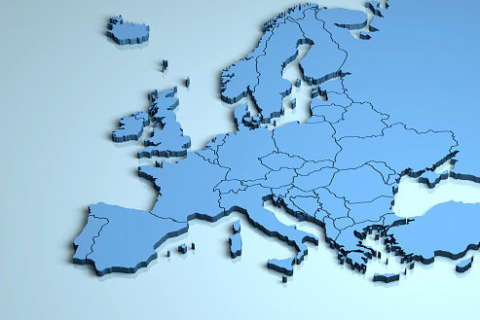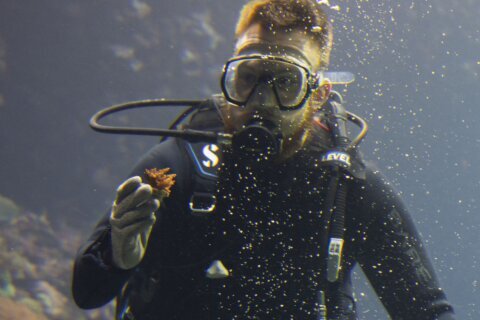A retired U.S. Navy cryptologist, crisscrossing Ukraine while mapping the possible routes a potential Russian attack might take, has warned Russia’s military that “Kyiv is not Beirut in 1983,” and that Ukrainian forces — and civilians — could mount a formidable defense.
“There’s a misimpression that this capital, this country, is a country under siege, like Damascus or Tripoli, Libya or Benghazi,” said Malcolm Nance, Executive Director of the Terror Asymmetrics Project on Strategy, Tactics and Radical Ideologies. “It’s not. This is a city the size of Chicago. There are three-and-a-half million people in this city alone, and they will fight.”
Sitting in downtown Kyiv on Monday, Nance observed a calm, resolute populace — with many dreading, but ready, to fend off a Russian incursion.
“There will be a rifle in every window, and the joke here is that a Russian invasion would be an invitation to the largest Molotov cocktail party in the history of the world,” Nance said.
U.S. intelligence suggests 50,000 people could die if Russian troops assault Kyiv from their positions over the Belarusian border less than 100 miles to the north, where joint drills began Thursday between Belarusian and Russian armed forces. By some estimates, Ukraine’s capital could quickly fall to foreign occupation.
But Nance discounts that possibility: “If they were driving unopposed, they could, in theory, get here in two-and-a-half hours, but it’ll probably take them two to three days.”
Regardless of what route they take, or how much opposition Russian forces face, Nance said emphatically: “They can get to the city — but they’re never taking the city.”
He envisions an all-hands-on-deck scenario if Russian troops enter Kyiv.
“Every person here … they’ll start throwing flower pots out of the windows at them, and breaking out Molotov cocktails and AK-47s,” Nance said. “This city will fight. This country won’t fall, and the Russians will lose an enormous amount of manpower.”
- Ukraine-Russia crisis: What to know about the fears of war
- More National Security News
- More Europe News
A growing show of force
The conflict grew out of Russia’s nebulous security demands, including that NATO leave the region, while blatantly ignoring the security needs of Ukraine and others, globally.
U.S. officials have said repeatedly that proposal is a non-starter. It is also a practical impossibility, because Latvia and Estonia, both former Soviet republics that are now full-fledged NATO member states, share a common border with Russia.
“We are on the front line of the NATO alliance,” said Kristjan Mäe, who leads the Estonian Ministry of Defense’s NATO and European Union department.
“The pillars of Estonian national security rely on our independent self-defense capabilities and obviously on the allied collective defense,” he said. “We are one of the allies who definitely emphasize the importance of the former as well as much as we do the latter.”
Mäe praised President Joe Biden for shifting military assets to Estonia, and other American allies in the Baltics and Eastern Europe.
“That is the latest example of the Astute Protector Exercise where six U.S. F-15s were deployed to Estonia, and then were integrated into the Baltic air policing mission originating from Estonia, and then also from Lithuania.”
Russia’s true objective
U.S. intelligence officials say Russia’s intentions are as yet unclear, because its leader, President Vladimir Putin, has not decided on a course of action.
But a top Estonian defense official believes Russian leadership is seeking something much grander than limiting Ukraine’s links to the West.
“Frankly speaking,” said Kusti Salm, permanent secretary in the Estonian Ministry of Defense, “it has very little to do with Ukraine. It has mainly to do with NATO. They want to push the borders back to what they were, basically, after the collapse of the Soviet Union. This would have a traumatic, catastrophic impact on Europe — in particular, for Estonia and Baltic states.”
Salm sees the way they’re going about it as alarming: “Russia (Putin) is acting opportunistically. He’s playing several cards at the same time. He has a diplomatic front open. He has military front open, and he has hybrid fronts open, all around Europe.”
Salm said in an extensive interview with WTOP that it’s all a part of a high-stakes global power gamble.
“They’re creating these strategic imbalances for each and every Western government, and I guess they’re just waiting for the hand that pays off the most,” Salm said.
As diplomacy efforts continue, Russian efforts to squeeze Ukraine are not relenting, triggering deep concern among other Democratic states in central and Eastern Europe.
“That’s why we hope to soon see the introduction and quick passage of a bipartisan bill deterring the Putin regime’s aggression through timely sanctions and other targeted measures,” said Karl Altau, Managing Director of the Joint Baltic American National Committee of the U.S.
But regardless of what happens on Capitol Hill, in the halls of power in other Western countries, or the outcome of the Ukraine conflict, Russia’s efforts to return Europe to a dangerous, bygone era are likely to continue.
“It’s not only the security arrangements that would be pushed back,” said Salm, “The prosperity, democracy and all this stuff will go back as well. That is what makes this so undigestible for us.”








